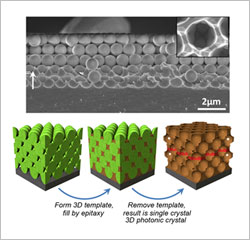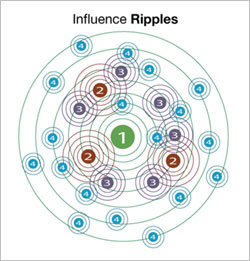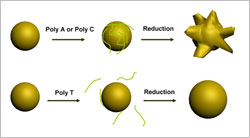The Beckman Institute Graduate Student Seminar Series presents the work of outstanding graduate students working in Beckman research groups. The seminar starts at Noon in Beckman Institute Room 1005 and is open to the public. Lunch will be served.
Controlling material structure from atomic to micron length scales: Single-crystal semiconductor photonic crystals for energy-related applications
Erik Nelson

Solving the challenges in creating the next generation of devices for energy-related applications will require the ability to simultaneously control the structure of materials across widely varying length scales. At the smallest length scale, the arrangement of atoms within a material influences its electronic properties (e.g. single-crystal Si for computer processors). Similarly, the material structure on larger length scales, hundreds of nanometers to microns, controls other properties such as propagation of light (e.g. fiber optics), collection of charge carriers (e.g. photovoltaics), etc. One material system that may help solve many of our energy challenges is photonic crystals, which are artificially structured materials that offer incredible control over the emission, absorption and propagation of light. However, scientists have been unable to simultaneously control the material structure over atomic and micron length scales for three-dimensional material architectures, limiting photonic crystals to materials with poor electronic performance. In this talk I will discuss a novel method to create materials that possess three-dimensional structuring on the length scale of hundreds of nanometers and the controlled atomic arrangement required for the aforementioned applications. These results enable a new class of materials with the potential to dramatically increase the efficiency of energy-related devices.
Search for topic initiator on the web
Xin Jin

In this talk we discuss a new web mining and search technique - Topic Initiator Detection (TID) on the web. Given a topic query on the internet and the resulting collection of time-stamped web documents which contain the query keywords, the task of TID is to automatically return which web document (or its author) initiated the topic or was the first to discuss about the topic. We design a system framework and propose algorithm InitRank to rank the web documents by their possibility to be the topic initiator. Experiments show that InitRank achieves the good performance with high effectiveness and robustness. We also show interesting findings in case studies.
DNA mediated control of metal nanoparticle shape: One-pot synthesis and cellular uptake of highly stable and functional gold nanoflowers
Zidong Wang

Shape control of nanomaterials is an active and important area of research as nanomaterials of different shapes, such as nanorods, prisms and cubes, exhibit unique properties for selective catalysis, sensitive sensing and enhanced imaging. Despite tremendous progresses made, the mechanism of the shape control is not well understood, in part due to the difficulty in defining the role of capping agents in nanoparticle growth. DNA is a well known biopolymer with more defined structure and conformation in solution and unique programmable nature to tune its functional properties. We demonstrate for the first time that DNA can be used to tune metal nanoparticle morphology in a sequence dependent manner. Poly A or poly C induced the formation the flower shaped gold nanoparticle, while poly T gave spherical nanoparticle. Mechanism of sequence dependent shape control from spherical to flower-like nanoparticle is also elucidated. Furthermore, DNA functionalization with high stability was realized in-situ during the one-step synthesis while retaining their bio-recognition ability. We have also shown that the DNA functionalized nanoflowers can be readily uptaken by cells and visualized under dark-field microscopy. These particles could find wide applications in fields such as bio-inspired nano-assembly, biosensing, and biomedicine.